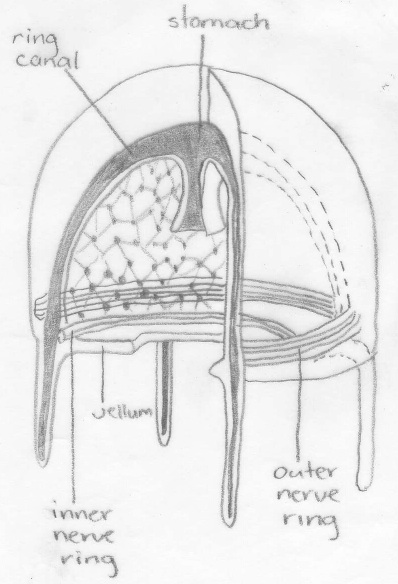Overview
Introduction
Economic Importance
Physical Description
Size
Ecology
Local Occurrence
Global Distribution
Crypsis
Life History & Behaviour
Life Cycle & Reproduction
Locomotion
Feeding (Report)
Anatomy & Physiology
Nervous System
Musculature
Respiration, Circulation & Excretion
Evolution & Systematics
Systematics
Conservation & Threats
Conservation
Threats
References |
NERVOUS SYSTEM
The nervous system in cnidarians is a rather superficial sensory system (Ruppert et al., 2004). Interconnected neurone form a complex nerve net that is two-dimensional (Ruppert et al., 2004). In cnidarians, there are two nerve nets, one that surrounds the epidermis (outer boundary layer) and one that surrounds the gastrodermis (the inner boundary layer). The two nerve nets are connected and nervous impulses travel through the nets in any direction (Ruppert et al., 2004). The medusa nerve nets are much more concentrated than those in other cnidaria (Ruppert et al., 2004) and can be seen in Figure 5.1 below.

Figure 5.1: Nervous system of a generalised
cnidaria. Adapted from Ruppert et al., 2004. |
As well as concentrated nerve nets, medusae also have nerve rings and ganglia (a brain-like nerve centre) that surround the margin of the bell (Ruppert et al., 2004). The nerve rings and ganglia are associated with sensory organs such as statocysts (seen in Figure 5.2) and ocelli (very simple eye-like sensory organs) (Ruppert et al., 2004). The statocyst is a gravity-sensing organ that allows the organism to determine their orientation within the water column. In hydromedusae, usually either the statocyst or ocelli are present, not both (Ruppert et al., 2004).

Figure 5.2: Statocyst on the bell margin of a generalised
hydromedusae (vertical section). Adapted from Ruppert et al.,
2004. |
|
|